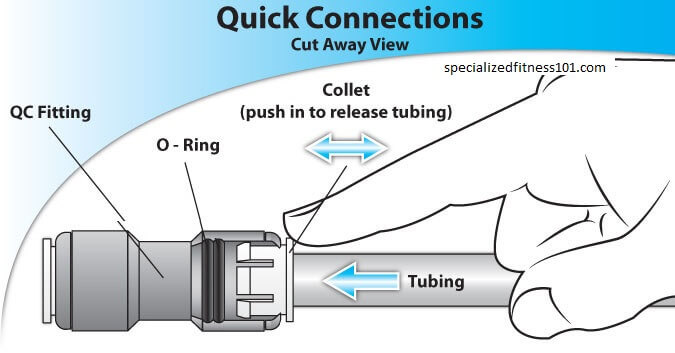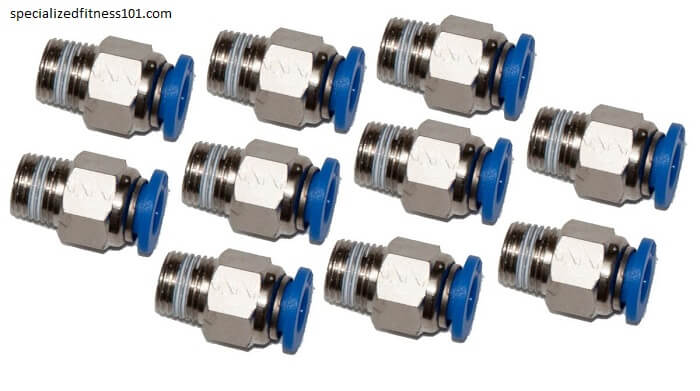The Convenience and Efficiency of Push-to-Connect Fittings: A Comprehensive Guide:
Push-to-connect fittings are a staple of modern piping and fluid control systems in most industries. They are simple, reliable, and efficient for connecting pipes or tubes without needing tools, soldering, or complex assembly processes. This article will discuss the main features, benefits, and applications of push-to-connect fittings and explain why they have gained popularity in industrial and residential settings.

What Are Push-to-Connect Fittings?
Connect Fittings:
Push-to-connect (PTC) fittings are connectors made for easy installation and removal of pipes or tubing in pneumatic, fluid, or gas systems. Users connect two pieces of tubing or piping by just pushing them into the fitting. Then, an inner mechanism—usually an O-ring and a locking mechanism—serves to secure the connection. No more threading, welding, or crimping.
These fittings are made out of strong materials such as brass, stainless steel, and plastic. They come in a lot of sizes, shapes, and configurations. Some of the PTC fittings may have swivels, valves, and adapters for more uses.
Key Features of Push-to-Connect Fittings:
Connect Fittings:
Push-to-connection fittings have several distinct characteristics which make them different from most other connection methods. Their prominent features include the following:
1. Tool-free Installation:
Connect Fittings:
The main advantage of push-to-connect fittings is that no tools are needed to install them. The design is simple, and workers can assemble or disassemble a system quickly without the need for specialized equipment, which in turn saves time and money in the long run.
2. Fast and Reliable Connections:
Push-to-connect fittings offer rapid connections that are especially handy for frequent change or fluid/pneumatic system maintenance in many industries. Quick Connect also offers a leak-free, secure connection with minimum failure risks.
3. Reusability:
Unlike traditional fittings, which may require replacement if disassembled, push-to-connect fittings are reusable. The internal components are designed to withstand repeated cycles of installation and removal without degrading, making them a cost-effective choice for industries that require frequent system modifications.
4. Versatility:
Push-to-connect fittings are very versatile and come in a wide variety of sizes and configurations to fit many different types of tubes, pipes, and hoses. They can be used in pneumatic systems, water lines, or even in some food processing environments, all depending on the specific needs for which they are being utilized.
5. Durability and Resistance:
Push-to-connect fittings are made from high-grade plastic, stainless steel, and brass. Therefore, they can withstand pressure, corrosion, and high temperatures in any environment. Hence, they can be applied practically in any application ranging from HVAC systems to automotive fluid lines.
Advantages of Using Push-to-Connect Fittings:
Push-to-connect fittings have several advantages over typical methods of connection. This is a list of them:
1. Time- Saving:
Push-to-connect fittings save much time for the installation process. The fact that no tool or special skill is needed means that workers can use their time for other things in the project, thereby making the overall productivity of the project better. This also means less labor cost and faster completion of the project.
2. Enhanced Safety:
The ease of use with push-to-connect fittings reduces the risk of installation errors, which could lead to leaks or system failures. Additionally, the secure nature of the connection helps to prevent accidental disconnections, promoting safety in industrial environments where system reliability is critical.

3. Cost-Effective:
Though more costly in the initial installation than comparable traditional fittings, push-to-connect fittings are long-term cost-effective. Being reusable with minimal installation time, significant savings can be made in terms of labor, maintenance, and lost time.
4. Space Efficiency:
Push-to-connect fittings may also save on space due to installations. Conventional fittings may involve additional equipment such as welding equipment, adhesives, or connectors, which occupy a significant amount of space. PTC fittings remove the requirement for such equipment and thus facilitate more compact and efficient systems.
5. Leak-Proof Performance:
Push-to-connect fittings feature a tight seal, which further reduces the possibility of any leakage in the system. They also have features such as O-rings and a locking mechanism that ensure the pipes or tubes remain connected even when subject to pressure or vibration. This makes PTC fittings of great use in systems whose leakage can cause dangerous or highly costly effects, such as in gas pipelines or hydraulic systems.
Applications of Push-to-Connect Fittings:
Push-to-connect fittings are used across a range of industries. They can be used to solve fluid handling problems and automation. Some of the most common applications include:
1. Pneumatic Systems:
Push-to-connect fittings are also widely applied in pneumatic systems, used to connect the tubes, which carry compressed air or gas. They are very easy to install; the quick and tool-free installation makes them especially appropriate for factory automation, assembly lines, and robotics applications where pneumatic systems need rapid and frequent adjustment.
2. Hydraulic Systems:
In hydraulic systems, push-to-connect fittings can be used in high-pressure fluid lines that offer secure, leak-free connections for such systems. Quick connection or disconnection of hydraulic systems makes it easy to access and troubleshoot.
3. Water and Gas Plumbing:
The use of push-to-connect also abounds in plumbing systems, both residential and commercial. Whether water pipes, gas lines, or heating systems, their capability to make fast, reliable connections has made them very popular among plumbers and contractors. They are highly useful in retrofit applications or working in tight spaces where other methods may be difficult to perform.
4. Food and Beverage Industry:
In the food and beverage industry, hygiene and reliability are very important. Push-to-fittings from food-grade materials, such as stainless steel or specific plastics, are common in fluid transfer systems for liquids and gases, thus being hygienic and easy to maintain.
5. Automotive and Transportation:
Push-to-connect fittings are also used in automotive and transportation systems, where they provide a simple, effective way to connect components in fluid lines, air brakes, or fuel systems. Their resistance to high temperatures and pressures makes them well-suited for the demanding conditions in these applications.
6. Medical and Laboratory Equipment:
Push-to-connect is indispensable in medical and laboratory environments where sterile, reliable connections are required. In such sensitive applications, ease of assembly and disassembly, along with secure, leak-free connections, become crucial. These fittings find their use in a variety of equipment, such as dialysis machines, diagnostic tools, and lab instrumentation.
Choosing Push-to-Connect Fittings:
There are multiple aspects to consider when it comes to selecting push-to-fittings for compatibility and longer performances. Some of them are as follows:
1. Material Compatibility
The fitting material needs to be compatible with the tubing or pipe being used along with the fluid or gas it is supposed to transport. This can include non-toxic materials for food-grade applications and corrosion-resistant metals such as stainless steel for industrial systems.

2. Pressure and Temperature Ratings
Ensure that the push-to-connect fitting is rated for the specific pressure and temperature conditions of the system. This is particularly important in high-pressure or high-temperature environments where the wrong fitting could lead to system failure.
3. Size and Configuration
Push-to-connect fittings exist in a range of different sizes and configurations to support any type of tubing or pipe. The choice of appropriate size is required to enable secure and leakage-free fit-ups. Secondly, elbow fittings, T fittings, and adapter fittings may also be necessitated for an intricate piping layout.
4. Maintenance and Life
Even though push-to-connects are made for reuse, they must be regularly maintained and inspected to ensure long-term usage. Internal components, such as O-rings, can degrade over time, which may cause leaks. Regular checks can prevent sudden failures.

